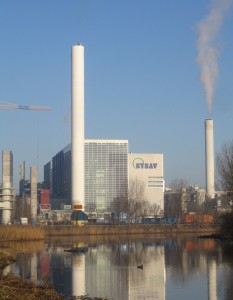First of all, a clarification. The prefix nano- seems to get attached to all sorts of stuff these days, especially in the science press, and it’s just begging for confusion. Nano-waste simply refers to synthetic particles on the nanometer scale that are engineered for some purpose, and are discarded along with the product when it has outlived its usefulness. It is nanotechnology in the broadest sense of the term – and we really need to be clearer about what we mean by nanotechnology going forward – though the conclusions reached by Walser, T. et. al. in the journal Nature Nanotechnology certainly has relevance to applications of small-scale computing (what we normally think about when we discuss nanotech) as well.
The particular problem raised by Walser, et al is that cerium oxide, a non-toxic synthetic used in catalytic converters, neither burns up nor biodegrades, so that it just sticks around and may eventually end up in our water supply and food cycle. Try to send it through an incinerator, and it will end up with the residue and tossed into a landfill, where it will persist indefinitely.
The good news is that cerium oxide is non-toxic and doesn’t escape into the atmosphere through the incineration process. The bad news is that it is not the only synthetic we have or are developing, and in many cases the environmental impact of the new compounds is not adequately tested. Once researchers find a practical use for them, they’re put to work without regard for whether we can get rid of them, or what they might do to us once they end their useful life and wind up in a pile of waste.
Cerium oxide is nothing new, but it took a while for anyone to get around to checking out where it ends up. There’s very little money for this kind of study, and governments can’t tighten up regulations on compounds that they don’t even know exist, and the potential damage from which can be underplayed by industry.
I think there’s a good science fiction side-plot in this for someone willing to take it up. It could just be an issue people have to deal with in a future Earth – damned miscellium keeps getting all over the place and they have to use special devices to filter it out of everything, special shampoos to get it out of their hair, and have to collect it up and dispose of it separately. You’d have a trash bin, a recycling bin, a yard waste bin, and a miscellium bin. Maybe it’s not harmful to humans, but it was built into the latest products decades ago, so now it’s everywhere, and in large volumes. Much larger volumes than it ought to be, actually. It’s almost as if it can somehow make more of itself . . .
Ahem. Anyway, there are possibilities for the fictional world and problems for the real world. Waste that we have trouble getting rid of is nothing new, but the sophistication and miniature size of the waste in question might be. Electronic Waste is already tough to handle as it is, and with mobile devices, our upgrade cycle is accelerating, and the technology is more pervasive. We are probably overdue for a discussion about how we deal with all of it before we get suffocated by it.
